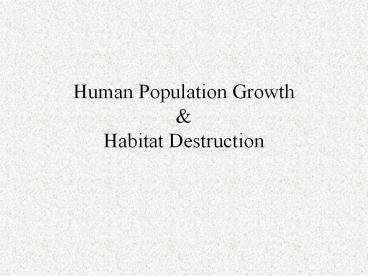Human Population Growth PowerPoint PPT Presentation
Title: Human Population Growth
1
Human Population GrowthHabitat Destruction
2
US population growth
- 1 b every........................... 8 seconds
- 1 d every......................... 12 seconds
- 1 i (net) every.................. 26 seconds
- Net gain of 1 every......... 13 seconds
3
zero pop change April, 2240
45,000 675,000
4
- Growth trend is not unique to US
- 2004 estimates (CIA website)
- India (1.07B)
- 2.85 children/woman
- 22.8 births/1,000 population
- 8.38 deaths/1,000 population
- ? 1.44
- Sudan (39.1M)
- 4.97 children/woman
- 35.79 births/1,000 population
- 9.37 deaths/1,000 population
- ? 2.64
- Greenland (58k)
- 2.42 children/woman
- 15.96 births/1,000 population
- 7.7 deaths/1,000 population
5
- http//www.census.gov/population/www/popclockus.ht
ml
6
5 min population growth ? 9503 8815 698
7
- 2.33 persons/sec
8
Question 1
- Human population growth is sometimes blamed for
the loss of biological diversity. Is this valid? - Is human population growth a concern for our
environment?
9
Habitat Destruction
- Almost all modern environmental problems are
linked to human population growth habitat
destruction. - HD - Destruction of wildlife habitats by
increasing pressure for land by fast-growing
human populations, pollution and
over-exploitation (EPA definition) - Examples
- Habitat conversion and fragmentation.
- Reductions in habitat quality, overexploitation
(harvesting, pet trading), (pollution, inc.
global temps, soil erosion, introduced
competitors/predators, etc.)
10
Tree harvesting
11
- Komi clearcuts
12
Habitat Conversion
- Wisconsin forest fragmentation
13
50 Million acres every year
14
Tropical Rainforests
15
Habitat Conversion
16
(No Transcript)
17
Mauna Loa, Hawaii
After the conversion
18
Overgrazing
19
Over harvesting
- Rotenone abuse
20
Results from digs of Paleolithic, archaeological
remains
21
Introduced (Exotic) species
22
(No Transcript)
23
(No Transcript)
24
Pollution
25
Manila Bay Pollution
26
Mexico City
27
Gasses trapped in ice pack
28
- Coal/oil fired pollutants
29
Extinctions (real and ecological)
Group Number of species Number threatened 1994 Number threatened 1999 percent
Fishes 24000 452 752 3
Amphibians 3000 59 146 5
Reptiles 6000 167 296 5
Boidae 17 9 53
Birds 9500 1029 1183 12
Mammals 4500 505 1130 25
Cervidae 14 11 79
Gymnosperms 758 242 - 32
Angiosperms 240000 21895 - 1
30
Question 2
- How do we value the diversity of life or natural
items? - How should we value them?
31
Why is biodiversity valuable?
- Direct values ? , meat, fibers
- Indirect values ?
- Aesthetics
- Religious
- Optional ? (e.g. rosy periwinkle)
- See next slides
- Intrinsic value
Vincristine - leukemia
Vinblastine Hodgkins disease
32
(No Transcript)
33
(No Transcript)
34
Question 3
- What choices do you make on a daily basis that
are good for the environment? - What choices do you make on a daily basis that
are bad for the environment?
35
Question 4
- Is the protection of the diversity of life a
moral decision?
36
Question 5 6
- Should we slow human population growth?
- How?

